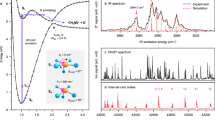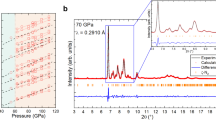Abstract
IN the quadratic form :  representing the harmonic approximation to the potential energy of a vibrating molecule, the ‘force constants’ k
rs depend on the definition of the internal co-ordinates q
i used to represent small changes in the molecular configuration. For example, a full analysis1 of the vibrations of 14NO2 and 15NO2, with co-ordinates q
1 and q
2 the NO bond stretches, gives for the stretch and stretch- interaction constants k
11 = K
22 and K
12 the following values (in units 105 dynes/cm.): (i) 10.884 and 1.9914 and (ii) 15.507 and 6.614 in the two cases where the third coordinate is (i) the ONO angle distortion and (ii) the change in OO distance. Thus the interpretation and comparison of force-constants obtained by different co-ordinate analyses present difficulties, which naturally increase with molecular complexity.
representing the harmonic approximation to the potential energy of a vibrating molecule, the ‘force constants’ k
rs depend on the definition of the internal co-ordinates q
i used to represent small changes in the molecular configuration. For example, a full analysis1 of the vibrations of 14NO2 and 15NO2, with co-ordinates q
1 and q
2 the NO bond stretches, gives for the stretch and stretch- interaction constants k
11 = K
22 and K
12 the following values (in units 105 dynes/cm.): (i) 10.884 and 1.9914 and (ii) 15.507 and 6.614 in the two cases where the third coordinate is (i) the ONO angle distortion and (ii) the change in OO distance. Thus the interpretation and comparison of force-constants obtained by different co-ordinate analyses present difficulties, which naturally increase with molecular complexity.
This is a preview of subscription content, access via your institution
Access options
Subscribe to this journal
Receive 51 print issues and online access
$199.00 per year
only $3.90 per issue
Buy this article
- Purchase on SpringerLink
- Instant access to full article PDF
Prices may be subject to local taxes which are calculated during checkout
Similar content being viewed by others
References
Cyvin, S. J., Acta Chem. Scand., 13, 1400 (1959), and unpublished calculations.
Author information
Authors and Affiliations
Rights and permissions
About this article
Cite this article
CYVIN, S., SLATER, N. Invariance of Molecular ‘Inverse’ Force-constants. Nature 188, 485 (1960). https://doi.org/10.1038/188485a0
Issue date:
DOI: https://doi.org/10.1038/188485a0
This article is cited by
-
Relating normal vibrational modes to local vibrational modes: benzene and naphthalene
Journal of Molecular Modeling (2013)



